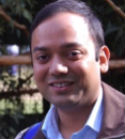 |
|
Scientist, Raytheon BBN Technologies
Saikat Guha is a Scientist with Raytheon BBN Technologies. He earned his Masters and Ph.D. degrees in EECS at MIT in 2004 and 2008 respectively under Prof. Jeffrey H. Shapiro, completing a thesis on fundamental results in establishing the ultimate quantum limits to the capacity of classical communications on point-to-point and multiple-user quantum optical channels. He received his B.Tech. in Electrical Engineering from the Indian Institute of Technology (IIT) Kanpur, India in 2002. Saikat represented India at the 29th International Physics Olympiad at Reykjavik, in July 1998 where he received the European Physical Society award for the experimental component. Saikat was a co-recipient of the NASA Tech Brief Award in 2010, awarded by the NASA Inventions and Contributions Board, for his work on the phase-conjugate receiver for Gaussian-state quantum illumination. Saikat is currently engaged in two DARPA "Information in a Photon" programs. He is the principal investigator on the Photon Information Efficient Communications (PIECOMM) program, which addresses the ultimate limits of spectral and photon efficiency of free-space optical communications. He is the lead theorist on another program that explores the Fundamental Information Efficiency of Electromagnetism with Squeezing and Spatial Entanglement (FINESSE). Saikat's research interests span across classical and quantum optical communications, error correction, network information theory, quantum sensing, and quantum algorithms.
Abstract
Quantum information theory has come a long way in defining several fundamental quantum-limited bounds on the performance of optics-based information processing systems, with applications ranging across communications, sensing and computation. Examples of such bounds are the Holevo bound on communications capacity, the Chernoff Bound on the error exponent for binary state discrimination with repeated interrogation, the quantum Cramer-Rao bound on the variance of an estimate of a parameter, and the Helstrom bound on the probability of error of discriminating between a set of quantum states. In several instances, quantum information theory has succeeded in not only finding these ultimate performance bounds, but also in developing rigorous proofs of the achievability of the bounds. However, most such proofs have been existential, and have evaded the issue of finding structured schemes to realize optimal quantum measurements using familiar optical components, such as mirrors, beamsplitters, phase-shifters, parametric amplifiers, etc., whose performance could approach the quantum-limited performance bounds. Measurements are ubiquitous, and lie at the heart of quantum mechanics and all applications thereof. But we are still far from a complete understanding of the realizability of general measurements permitted by the laws of quantum physics. In this talk, we will present a brief unified review of recent developments in our understanding of structured optical realizations of quantum measurements, both in the context of optical communications and sensing, and will present several difficult open questions that lie ahead.
|



